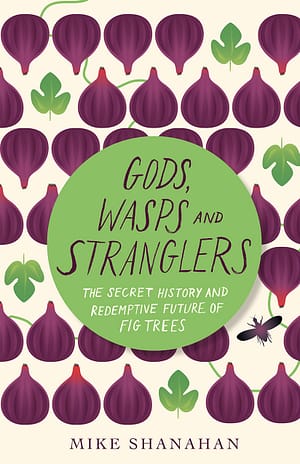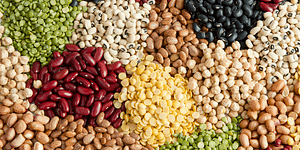Fig Trees: Snakes and Ladders & Tantalising Figs

You ever think about how important fig trees are to ecosystems all over the world? Me neither… until I read Gods, Wasps, and Stranglers. The complex nature of these trees and their interdependence with their surroundings is beyond fascinating.
“As our planet’s climate changes and reminds us that nature really does matter, the story [of fig trees] has important lessons for us all.” – Mike Shanahan
In short, fig trees are awesome.
The following excerpt is the first chapter from Gods, Wasps, and Stranglers. It has been adapted for the web.
Snakes and Ladders & Tantalising Fig Trees
The figs were big orange beacons that lured me from afar. The snake was lime green and venomous and just centimetres from my face. I found them both near the top of a tall tree in a Bornean rainforest.
While the snake was safely coiled on a sturdy branch, all I had were some sweat-soaked fingers to save me from a fall. My heart raced. The snake’s unblinking eyes looked as patient as time.
The year was 1998, and I was falling headlong into a fascinating story. The stars of the story are the fig trees—the 750 or so Ficus species. Over millions of years these trees have shaped our world, influenced our evolution, nourished our bodies and fed our imaginations. The best could be yet to come.
Fig trees could help us restore ravaged rainforests, stem the loss of wild species and even limit climate change. They could build vital bridges between scientific and faith-based world views. Their story reminds us of what we all share. It warns us of what we could lose.
In Greek mythology, a branch laden with sweet figs was among the temptations that teased the demigod Tantalus during his punishment in the Underworld.
Each time Tantalus reached for the figs, the wind wrenched the tree’s bough beyond his reach. This tale gave English the verb ‘to tantalise’. Those dull orange figs in Borneo, with their guardian snake, seemed certain to elude me too. I craved them, though I had no desire to eat their flesh.

As it rises, it paints its host tree’s bark green with thousands of little leaves. This species relies heavily on primates to eat its figs and disperse the tiny seeds within them.
But in this particular forest, Ficus aurantiaca was a plant with problems.
First, few primates remained in the area. The national park I was in was an island of ancient forest, at whose edges lapped a biting tide of oil palm plantations, farms and logging concessions.
These man-made habitats posed dangers to primates and other wildlife. Like the national park itself, they were often visited by shotgun-toting hunters for whom a monkey or a gibbon would be a prize kill.
But even if primates had been abundant, something else was wrong. Like all fig species, Ficus aurantiaca depends on tiny wasps to pollinate its flowers.
That year, however, an intense drought had stricken the national park. By forcing Ficus aurantiaca to stop producing figs, the drought had driven these insects into local extinction.
Across the national park many other Ficus species faced the same problem. Without figs and fig-wasps, the plants could not reproduce. The many bird and mammal species that rely on figs as food faced a serious fruit shortage.
And that would have knock-on effects for the other plants whose seeds these creatures dispersed. That’s why I was so interested in the Ficus aurantiaca figs I spotted that day. They were a sign that life might be returning to normal.
But to be sure, I needed to know what was going on inside them. All that lay between my curiosity and the answers I sought was that venomous snake and the risk of a long fall.
I was hanging from the last of seven ladders that somebody had lashed, toes-to-shoulders, flush to the tree. I had not brought a safety harness but climbed nonetheless. Those figs had banished security from my mind. As I tried to maintain my grip on the metal rungs, an intense wave of vertigo paralysed me.
For a moment I could no longer sense my own body. It was as if my mind was all that existed of me, and it scrambled to process the sudden danger. I held my breath. Solid ground was a long way down, but I needed those figs and that meant I had to let go of the ladder with one hand to reach past the snake.
My obsession with figs had long since taken root. In the years ahead it would take me to temples, mountaintops and into the crater of an active volcano. It would stay with me long after I stopped studying biology. It would take solid form in the pages of this book. It has been a long and fruitful journey.
I first encountered these plants in my childhood home. One lived inside in a plastic pot and inched its way towards whatever light it could find. Just a metre high and spindly of limb, it would fall over if my sister or I ran past it too quickly.
I was the youngest member of the family, so the periodic task of cleaning the tree’s leaves fell to me. As I stroked each dark green leaf with a soft yellow duster so it shone, I couldn’t fail to notice the label that stood upright like a tombstone in the soil.
The exotic words there—Ficus benjamina—made no sense to my young eyes. Years would pass before I understood what those words meant and before I learned that this frail plant was a mere baby.
As one of the most common houseplants in the world, Ficus benjamina is seen more often indoors than out. But in the forests of Asia, this species can reach 30 metres in height. Its reddish pea-sized figs sustain dozens of wild animal species.
My mum referred to the plant in our hallway as ‘the fig tree’. This confused me, as outside, in our next-door neighbours’ garden, there was
Despite their differences, both plants were indeed fig trees, distant cousins with a common ancestor. This was my first exposure to the rich variety of fig species that has kept biologists busy for more than 2,300 years.
The leaves of the plant inside were small and smooth, but those of the tree outside were rough to touch and wider than my dad’s handspan.
Unlike the tiny tree inside, the one outside was big enough to peer down at me from behind the two-metre tall wall that separated our garden from our neighbours’.
And unlike the barren houseplant, the one outside often tempted me with its fruit—soft and tasty figs. It was Ficus carica, the so-called edible fig.
The ancient Greeks valued this species so much they believed it to be a gift from the gods.
These fig trees sowed in my young mind some seeds that would long lay dormant. In time they germinated into a garden of fascination.
Fig trees would show me the world through different eyes and different taste buds—those of diverse cultures from the present day and the distant past, as well as those of bats and birds, monkeys and much stranger beasts.
This germination began in 1994, at the University of Leeds, in a lecture by biologist Steve Compton. He would later list his research interests on the university website as including ‘anything to do with fig trees and figwasps’. I had never heard of a fig-wasp.
Steve changed my life when he taught me their story. It’s a story to which DH Lawrence alluded in his poem about the ‘Wicked fig tree’ with its ‘self-conscious secret fruit’.
Lawrence hinted at the trait that characterises all Ficus species and explains why they matter so much. It relates to sex.
For any species of flowering plant to reproduce sexually, male pollen must fuse with female ovules—just like the sperm and eggs of mammals. The fertilised ovules turn into seeds. These are plant embryos.
They develop inside their mother flowers until they are ready to disperse and take their chances in the game of life.
Some plants rely on the wind to transfer their pollen, but the vast majority need help from animals. Many rely on insects such as beetles, bees and butterflies, which spread pollen as they wander from flower to flower.
More rarely, birds or mammals provide the service. Bats that feed on nectar pollinate the flowers of the blue agave, the succulent plant that is the source of tequila. Their pollen-dusted noses fit into the agave flowers like hands into gloves.
Figs and their fig-wasp pollinators have an even tighter relationship, but have you ever seen flowers on a fig tree? I think not.
Sit under a Ficus tree every day of your life and you will see it produce crop after crop of figs but never a single flower. The mystery of this apparent virgin birth has endured for millennia. It is why ancient Hindu and Buddhist texts use the phrase ‘seeking flowers in a fig tree’ to describe a hopeless search.
It’s why a Bengali saying describes someone who has become ‘invisible like a fig flower’. And why the Chinese characters for fig—無花果—mean ‘the flowerless fruit’. The ancient phrase-makers never looked closely enough.

Here is the secret: the fig is not a fruit at all. It is a hollow ball whose entire inner surface is lined with tiny flowers that never see daylight.
The mystery of the hidden flowers arose as many as 80 million years ago when fig trees and fig-wasps forged a fortuitous bond that became biological shackles for them both.
Fig flowers were once out in the open but, as the ancestors of today’s Ficus and fig-wasp species developed their codependence, the plants evolved to exclude many other species from their flowers.
Over generations, the platforms upon which the flowers stood developed into urn-like figs that hid the blooms away. Since then figs and fig-wasps have spread across the planet and diversified into an astonishing variety of species.
Today, every one of the 750 plus Ficus species is pollinated by just one or more tiny wasp species that can feed and breed only in their fig partner’s flowers. The Ficus and fig-wasp species cannot survive without each other.
Their destinies are bound together, and many more species gain as a result. I know because I counted just one group of beneficiaries and it took me years.
To find out which animals eat figs, I trawled through hundreds of scientific papers, recorded my own observations and begged biologists to share unpublished data. The list that emerged was more motley than I could have imagined.
It included elephants and opossums, bearded pigs and spectacled bears, mongooses, bandicoots and tree kangaroos. I found records of 90 species of fruit bat and 80 species of primate eating figs. Deer, cattle and antelopes eat them. So do rats, mice and more than 30 species of squirrel.
I even found records of fig-eating by giant tortoises and jackals, kingfishers and seagulls and several species of fish. The list included hundreds of species of birds, from pheasants to orioles, ostriches to woodpeckers and more than 120 species each of parrots and pigeons.
In all, I found that figs feed at least 1,274 species of birds and mammals— far more than any other type of fruit. These animals in turn disperse the seeds of thousands of other plant species.
So figs help to sustain life across entire landscapes, and it is because of this that I came to be in Borneo, hanging from a ladder high up a tree.
Tantalus never got his figs, but I got mine. As I plucked each one and shoved it into my pocket, sticky white latex oozed from the wounds I inflicted. This gummy sap is common to all fig species.
It deters insects from feeding on them, and it speeds recovery from injuries. For millennia, people have found ways to make fig latex work for them too. They have smeared it on branches to catch birds, curdled milk with it to make cheese, processed it to make rubber and used it as an aphrodisiac.
I was glad of the latex 
The snake had not moved a single scale.
Back at my workbench in my research station in the national park, I picked up a sharp scalpel and sliced into each fig.
One by one they opened like mouths with nothing to say—they were barren hollows. Their flowers were unpollinated. They bore no seeds.
Their pollinator wasps had not returned. My climb had been in vain.
It may seem strange to take risks in search of rare figs, but by the time I met that snake in 1998, I had come to understand three things: that fig trees play important roles in rainforests; that they have influenced diverse human cultures; and that today we are both destroying the former functions and forgetting the latter.
Back then the science was fascinating enough. But I was learning too about a chain of reverence towards fig trees that coils back in time for many thousands of years and encircles the globe.
Fig trees appear in mythologies in the Amazon and in Africa, across the Mediterranean and the Middle East, and from the foothills of the Himalayas to the islands of the South Pacific.
They feature in some way in every major religion, starring in the stories of Krishna and Buddha, Jesus and Muhammad. But these are all just recent examples. Fig trees were inspiring, sustaining and even protecting our ancestors long before they invented writing or domesticated the dog.
They were among the first plants people cultivated, and their figs are among the most nutritious of foods we eat today. Thanks to their curious biology, arguably no other group of plants holds as much ecological importance, evolutionary interest and cultural value.
Our shared story stretches back beyond the birth of our species, back to before our ancestors descended from the trees and walked upright for the first time. It is a story of life and death and of a deal undone.
Its cast includes kings and queens, gods and prophets, flying foxes and ‘botanical monkeys’. It features scientific and religious wonders born from biology that seems almost impossible in its elegance. Most of all it is a story about our relationship with nature.
The story stretches back tens of millions of years to the age of the giant dinosaurs, but is as relevant to our future as to our past. As our planet’s climate changes and reminds us that nature really does matter, the story has important lessons for us all.
Recent Articles
Oxeye daisies are one of the most important plants for pollinators including beetles, ants, and moths that use oxeye daisies as a source of pollen and nectar. Instead of thinking about removing a plant like oxeye daisy, consider how you can improve the fertility and diversity of habitat resources in your home landscape, garden, or…
Read MoreThis long-lived perennial legume is used for forage and erosion control. Kudzu is edible with many medicinal uses and other applications. Pollinators of all kinds love its prodigious lavender blooms!
Read MoreMove aside, maple! We have two new syrups to add to the table. Read on for insights on tapping, selling, and eating syrup from walnut & birch trees.
Read MoreWhy is modern wheat making us sick? That’s the question posed by author Eli Rogosa in Restoring Heritage Grains. Wheat is the most widely grown crop on our planet, yet industrial breeders have transformed this ancient staff of life into a commodity of yield and profit—witness the increase in gluten intolerance and ‘wheat belly’. Modern…
Read MoreDid you ever wonder how leeks, kale, asparagus, beans, squash, and corn have ended up on our plates? Well, so did Adam Alexander, otherwise known as The Seed Detective. The following is an excerpt from the The Seed Detective by Adam Alexander. It has been adapted for the web. My Seed-Detective Mission Crammed into two…
Read More








